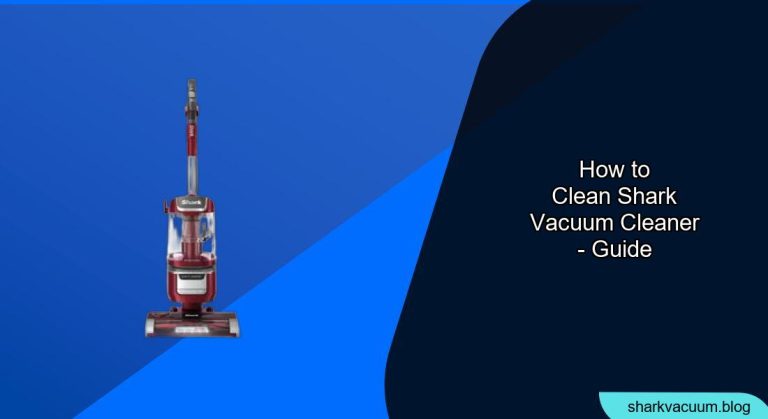A Shark vacuum is a powerful tool for keeping your home clean and allergen-free. However, like any appliance, it requires regular maintenance to function optimally. A dirty vacuum can lose suction, spread dust and allergens, and even overheat. This guide provides a comprehensive, step-by-step process for cleaning your Shark vacuum, ensuring it continues to deliver peak performance for years to come.
Keeping your Shark vacuum clean isn’t just about tidiness; it’s about maximizing its lifespan and cleaning efficiency. A clogged filter or a tangled brushroll can significantly reduce suction power, making your cleaning efforts less effective. By investing a little time in regular maintenance, you’ll not only enjoy a cleaner home but also save money by avoiding costly repairs or replacements. Let’s dive into how to properly clean your Shark vacuum.
Table of Contents
Emptying the Dust Cup

The dust cup is where all the dirt and debris collect, so emptying it regularly is crucial.
- Unplug the Vacuum: Always start by unplugging your Shark vacuum from the power outlet for safety.
- Detach the Dust Cup: Locate the release button or latch for the dust cup. It’s usually near the top or front of the vacuum body. Press the button and gently pull the dust cup away from the vacuum.
- Empty the Debris: Hold the dust cup over a trash can and press the release button to open the bottom. Shake the cup gently to dislodge any stuck debris. Some models have a second release button to open the top of the dust cup for more thorough emptying.
- Clean the Dust Cup (If Necessary): If the dust cup is particularly dirty or has stuck-on debris, you can wash it with warm, soapy water. Ensure the cup is completely dry before reattaching it to the vacuum.
Cleaning the Filters
/how-to-clean-shark-vacuum-filter-5217133-06-81debb2bce5e48668277f5ad4fbe11f4.jpg)
Shark vacuums typically have multiple filters that need regular cleaning to maintain suction power.
- Locate the Filters: The location of the filters varies depending on the Shark vacuum model. Common locations include the top of the dust cup, behind the dust cup, or near the motor. Consult your owner’s manual for specific locations.
- Remove the Filters: Gently remove the filters from their housing. Some filters may be washable foam or felt, while others may be HEPA filters.
- Clean Foam and Felt Filters: Rinse foam and felt filters with warm water until the water runs clear. Gently squeeze out excess water and allow the filters to air dry completely for at least 24 hours before reinstalling them. Never use soap on HEPA filters.
- Clean HEPA Filters: HEPA filters are more delicate and should not be washed. Instead, gently tap the filter against a trash can to remove loose dust and debris. You can also use a soft brush to clean the filter surface. Replace HEPA filters according to the manufacturer’s recommendations (usually every 6-12 months).
- Reinstall the Filters: Once the filters are completely dry (or cleaned), reinstall them in their proper order and location. Ensure they are securely in place.
Removing Hair and Debris from the Brushroll
A tangled brushroll can significantly reduce your vacuum’s cleaning performance.
- Identify the Brushroll: Locate the brushroll on the vacuum head. Some Shark vacuums have a self-cleaning brushroll that actively removes hair wraps, while others require manual cleaning.
- Access the Brushroll: Depending on the model, you may need to use a screwdriver or coin to unlock the brushroll cover. Refer to your owner’s manual for specific instructions.
- Remove Hair and Debris: Use scissors or a seam ripper to carefully cut away tangled hair, threads, and other debris from the brushroll. Be careful not to damage the bristles.
- Clean the Brushroll Housing: Remove any remaining debris from the brushroll housing using a small brush or cloth.
- Reinstall the Brushroll: Place the brushroll back into its housing and secure the cover. Ensure the brushroll spins freely.
Checking and Cleaning the Hoses and Attachments
Clogs in the hoses and attachments can also reduce suction power.
- Detach the Hose: Disconnect the hose from the vacuum body and the vacuum head.
- Inspect for Clogs: Look through the hose to check for any visible clogs.
- Remove Clogs: Use a broom handle or similar tool to gently push any clogs through the hose. Be careful not to puncture the hose.
- Rinse the Hose (If Necessary): If the hose is particularly dirty, you can rinse it with warm water. Ensure the hose is completely dry before reattaching it to the vacuum.
- Clean Attachments: Clean any attachments, such as crevice tools or upholstery brushes, with warm, soapy water. Rinse and dry thoroughly before storing.
- Reattach the Hose: Reconnect the hose to the vacuum body and the vacuum head, ensuring it is securely in place.
Cleaning the Exterior
Wipe down the exterior of your Shark vacuum regularly to remove dust and grime.
- Damp Cloth: Use a damp cloth to wipe down the vacuum body, handle, and other exterior surfaces.
- Mild Detergent (If Necessary): For stubborn dirt or stains, use a mild detergent diluted in water.
- Dry Thoroughly: After cleaning, dry the vacuum with a clean cloth to prevent water spots.
Troubleshooting Guide
Here are some common problems and solutions to help keep your Shark vacuum running smoothly:
- Problem: Vacuum loses suction.
- Solution: Empty the dust cup, clean the filters, and check for clogs in the hose and attachments.
- Problem: Brushroll stops spinning.
- Solution: Turn off and unplug the vacuum. Remove any tangled hair or debris from the brushroll. Check the brushroll motor for obstructions.
- Problem: Vacuum smells bad.
- Solution: Clean the dust cup and filters thoroughly. You can also place a cotton ball soaked in essential oil in the dust cup to freshen the air.
- Problem: Vacuum overheats.
- Solution: Unplug the vacuum and allow it to cool down. Check for clogs that may be causing the motor to work harder than it should.
- Problem: The vacuum is difficult to push.
- Solution: Clean the wheels and ensure they are free of hair and debris.
FAQ Section
How often should I clean my Shark vacuum?
Ideally, you should empty the dust cup after each use and clean the filters every 1-3 months, depending on how frequently you use your vacuum. The brushroll should be cleaned as needed, typically every few weeks.
Can I put my Shark vacuum filters in the washing machine?
No, it is not recommended to put your Shark vacuum filters in the washing machine. The harsh detergents and agitation can damage the filter material. Hand-washing with warm water is the best method.
How do I know when to replace my Shark vacuum filters?
Replace your Shark vacuum filters when they are visibly damaged, heavily soiled, or no longer effectively trapping dust and allergens. The HEPA filter typically needs to be replaced every 6-12 months, while foam and felt filters can last longer with proper cleaning.
What is the best way to remove pet hair from my Shark vacuum brushroll?
Use scissors or a seam ripper to carefully cut away tangled pet hair from the brushroll. For stubborn hair, you can try using a specialized brushroll cleaning tool.
Can I use my Shark vacuum without the filters?
No, never use your Shark vacuum without the filters in place. The filters protect the motor from dust and debris, and operating the vacuum without filters can cause serious damage.
Where can I find replacement parts for my Shark vacuum?
You can find replacement parts for your Shark vacuum on the SharkClean website, Amazon, or at authorized retailers. Make sure to purchase parts that are specifically designed for your vacuum model.
Tips, Warnings, and Best Practices
- Safety First: Always unplug your Shark vacuum before performing any maintenance or cleaning tasks.
- Read the Manual: Refer to your owner’s manual for specific cleaning instructions and maintenance recommendations for your model.
- Use Genuine Parts: When replacing filters or other parts, use genuine Shark replacement parts to ensure optimal performance and avoid voiding your warranty.
- Avoid Water Damage: Never submerge the vacuum body or motor in water.
- Regular Maintenance: Consistent cleaning and maintenance will extend the life of your Shark vacuum and keep it running at peak performance.
Conclusion
Cleaning your Shark vacuum is essential for maintaining its performance and prolonging its lifespan. By following these simple steps, you can ensure your vacuum continues to effectively clean your home for years to come. Regular maintenance not only improves cleaning efficiency but also helps to prevent costly repairs and replacements. So, take the time to care for your Shark vacuum, and it will continue to take care of your home. Now that you know how to properly clean your Shark vacuum, schedule regular cleanings to keep it running like new. Don’t wait until the suction fades – a little maintenance goes a long way!







